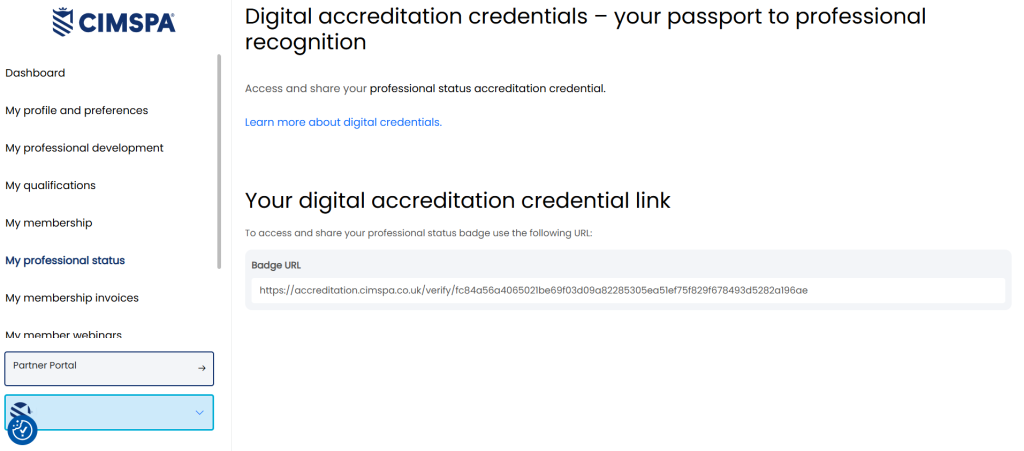Individuals with a CIMSPA professional status have access to their own unique digital accreditation credential, providing an additional opportunity to gain the recognition they deserve for the expertise, standards and commitment they adhere to each and every day.
With an ever-expanding online marketplace, it’s critical you have the tools to showcase your position as a dedicated and qualified professional within our sector.
That is why we have designed a range of digital badges that accompany your professional status confirming your credentials.
As a professional in our sector, we urge our members to embrace this opportunity. Step up, stand out and use your professional identity.
What is an accreditation credential?
Accreditation credentials are secure, visual, digital representations of an individual’s verified status, qualifications or achievements. Some might describe them as akin to a digital version of a certificate, but they are much more sophisticated than that.
Each badge is directly linked to the issuing body and details the standards met, the date of issue and whether that credential needs to be renewed.
They provide real-time, tamper-proof evidence of competence and professionalism. They are completely portable and can easily be added to LinkedIn profiles, email signatures, CVs, digital portfolios or booking platforms, ensuring the recognition of skills and professional standing is transparent, shareable and verifiable.

Above: Example accreditation credential visuals for practitioner professional statuses.
Why should I use my accreditation credential?
It’s no coincidence that digital credentials are used widely across sectors such as healthcare, education, technology, and construction and engineering. They offer a dynamic and hugely effective way in which to communicate any skills acquired or competencies gained, and greater visibility with employers and clients as a way to stand out in a competitive market.
Digital accreditation credentials give sport and physical activity professionals, whether as a practitioner, manager or leader, a dynamic way to showcase their status, career progress and commitment to excellence as a sector professional.
They also enable individuals to showcase their career progress and development with a digital record of growth that evidences continuous improvement.
Ultimately, digital accreditation credentials will evidence to clients and other stakeholders via tangible and verifiable proof that you are competent, aligned to national standards and have a commitment to excellence as a sector professional.
They also help to shift perceptions of the sector, because they demonstrate that being part of the sport and physical activity sector is a legitimate, impactful and recognised profession.
How can I use my accreditation credential?
If you have a professional status, you can access your accreditation credential through your CIMSPA dashboard in the “My professional status” tab.

Open the link to view your badge, then copy the URL to wherever you want to use it – when you paste the link into a post on social media, a preview of your badge will automatically load to show your status quickly and easily.
Here are a few ways that you can share it effectively to support your professional recognition:
- Embed it in your email signature
- Showcase it on your website
- Share it on professional networking sites like LinkedIn
- Showcase it via social media such as Facebook, Instagram or X
- Add it to your digital CV or e-portfolio
Encourage your clients, employer, peers and everyone else to check your credential to verify your status as a true professional in sport and physical activity.
What is to stop somebody from copying my accreditation credential?
All reputable providers of digital badging solutions have robust verification processes to ensure each and every badge is genuine and can efficiently be verified and identified as genuine.
Each digital accreditation credential is unique. When clicked, it will take the user to a page that will either notify them of a verified professional status or that the authentication failed.
This is based on a variety of data that feeds into live authenticity validation results that serve to check and confirm the below details in order to provide a trustworthy signal of competence and credible proof of skills and achievements.
- Professional status – this indicates the member’s current professional level within CIMSPA’s framework. Postnominals (like MCIMSPA) show their membership grade and professional standing.
- Earning criteria – this describes the specific requirements and competencies the member demonstrated to earn this credential, ensuring they meet professional standards.
- Digital verification – this confirms the digital credential is secure and allows the user to verify in real-time against CIMSPA’s database, ensuring its authenticity and current status.
- Issue and expiry dates – these dates show when the credential was issued and when it expires. CIMSPA digital accreditation credentials require ongoing professional development to maintain validity.
While it may be achievable to recreate the design of your accreditation credential, the lack of verifiable data and issuer verification mean it is clear when a badge is a counterfeit.
Are accreditation credentials effective?
When it comes to communicating and showcasing any skills acquired or competencies gained, digital credentials are an incredibly powerful tool that offer tangible recognition on a multitude of digital platforms that have significant capabilities in terms of reach.
CIMSPA has already piloted digital credentials through its Chartered Member category, providing a strong foundation for this wider rollout.
Chartered Members received personalised, verifiable digital badges that could be easily shared across platforms and the response was overwhelmingly positive. Members valued the ability to clearly demonstrate their chartered status and expertise, while employers, deployers and clients fed back that the credentials made it easier to verify competencies, understand an individual’s level of professionalism and build trust.
This early success confirmed what we had anticipated: that digital accreditation credentials offer a clear, credible and modern way to recognise professional status.